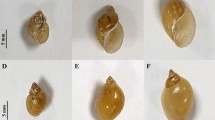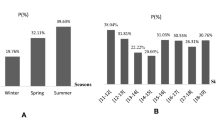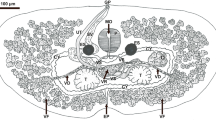Abstract
Amber Succinea putris snails were collected in the Leningrad Region (Russia). Some of them were infected with trematodes Leucochloridium paradoxum, Leucochloridium perturbatum and Leucochloridium vogtianum. One snail had triple infection with all these species. Genotyping of sporocysts by ITS1–5.8S–ITS2 nucleotide sequences of ribosomal DNA (rDNA) and phylogenetic analysis were performed. The results confirmed the species identification of sporocysts of Leucochloridium based on the shape and colour of mature broodsacs. Sporocyst broodsacs could leave the host snail on their own, remaining viable in the environment for up to an hour. This ability of sporocysts may prevent the excessive infection of the molluscan host.



Similar content being viewed by others
References
Ataev GL, Dobrovolskij AA (1992) Development of microhemipopulation of Philophtalmus rhionica rediae in molluscs naturally infected with other species of trematodes. Parazitologya 26:227–233
Ataev GL, Tokmakova AS (2015) Seasonal changes in the biology of Leucochloridium paradoxum (Trematoda, Leucochloridiomorphidae). Parazitologya 49:200–207
Ataev GL, Babich PS, Tokmakova AS (2013) The study of the sporocyst broodsacs coloring in Leucochloridium paradoxum (Trematoda: Brachylaemidae). Parazitologya 47:372–379
Bakke TA (1982) Histology and biology of the larval stages of Leucochloridium Carus, 1835 (Trematoda, Digenea) as revealed by light and electron microscopy. Fauna Norv Ser A 3:41–56
Baudon A (1881) Troisième supplement à la monographie des Succinées françaises. J Conch 29:139–154
Casey SP, Bakke TA, Harris PD, Cable J (2003) Use of ITS rDNA for discrimination of European green- and brown-banded sporocysts within the genus Leucochloridium Carus, 1835 (Digenea: Leucochloriidae). Syst Parasitol 5:163–168. doi:10.1023/B:SYPA.0000003809.15982.ca
Combes C (1995) Interactions durables: écologie et évolution du parasitisme. Masson, Paris
Fernandez J, Esch GW (1991) The component community structure of larval trematodes in the pulmonate snail Helisoma anceps. J Parasitol 77:540–550. doi:10.2307/3283157
Fried B, Lewis P, Beers K (1995) Thin-layer chromatographic and histochemical analyses of neutral lipids in the intramolluscan stages of Leucochloridium variae (Digenea, Leucochloridiidae) and the snail host, Succinea ovalis. J Parasitol 81:112–114. doi:10.2307/3284019
Ginetsinskaya TA (1953) Importance of color of sporocyst of trematodes of the genus Leucochloridium in determining the species. Dokl Akad Nauk SSSR 88:177–179, in Russian
Ginetsinskaya TA (1964) The questions of ecology and systematics of Leucochloridium parthenogenetic generation. Trudy Leningradskogo obscestva Estestvoispytatelej 72:38–56 (in Russian)
Ginetsinskaya TA (1988) Trematodes, their life cycles, biology and evolution. Amerind Publishing Company, Pvt, New Delhi
Hotenovskij IA (1963) On the fauna of Trematoda of birds in the Leningrad region. In: Pavlovskij E (ed) Parasitological collection. Academy of Science USSR, Moscow, pp 203–208
Jackiewicz M (1982) Leucochloridium vogtianum Baudon, 1881 (Trematoda) new for the Hungarian fauna. Miscnea zool hung 1:25–26
Kimura M (1980) A simple method for estimating evolutionary rate of base substitutions through comparative studies of nucleotide sequences. J Mol Evol 16:111–120
Kumar S, Tamura S, Nei M (2004) MEGA3: integrated software for molecular genetics analysis and sequence alignment. Brief Bioinform 5:150–163. doi:10.1093/bib/5.2.150
Kuris A (1990) Guild structure of larval trematodes in molluscan hosts: prevalence, dominance and significance of competition. In: Esch G, Bush A, Aho J (eds) Parasites communities, patterns and processes. Chapman and Hall, Springer, Netherlands, pp 69–100. doi:10.1007/978-94-009-0837-6_4
Michot B, Despres L, Bonhomme F, Bachellerie JP (1993) Conserved secondary structures in the ITS2 of trematode pre-rRNA. FEBS Lett 316:247–252. doi:10.1016/0014-5793(93)81301-F
Morgan JA, Blair D (1998) Trematode and monogenean rRNA ITS2 secondary structures support a four-domain model. J Mol Evol 47:406–419. doi:10.1007/PL00006398
Olson PD, Cribb TH, Tkach VV, Bray RA, Littlewood DTJ (2003) Phylogeny and classification of the Digenea (Platyhelminthes: Trematoda). Int J for Parasitol 33:733–755. doi:10.1016/S0020-7519(03)00049-3
Pojmanska T (1962) On sporocysts of the genus Leucochloridium in Poland. Acta Parasitol Pol 10:369–376
Posada D, Crandall KA (1998) Modeltest: testing the model of DNA substitution. Bioinformatic 14:817–818. doi:10.1093/bioinformatics/14.9.817
Rietschel G (1972) Untersuchungen über Farbmuster-Typen bei Leucochloridium Sporocysten (Trematoda, Brachylaemidae) und deren Zugehörigkeit zu bestimmten Arten. Z Parasitenkd 40:61–68. doi:10.1007/BF00329616
Sambrook J, Russel DW (2001) Molecular cloning: a laboratory manual. Cold Spring Harbor, New York
Sousa WP (1990) Spatial scale and the processes structuring a guild of larval trematode parasites. In: Esch G, Bush A, Aho J (eds) Parasites communities, patterns and processes. Chapman and Hall, Springer, Netherlands, pp 41–67. doi:10.1007/978-94-009-0837-6_3
Wesenberg-Lund C (1931) Contributions to the development of the Trematoda Digenea. I. The biology of Leucochloridium paradoxum. D Kgl Dansk Vidensk Selsk Skrifter Naturw Math Afd 4:90–142
Woodhead E (1935) The mother sporocysts of Leucochloridium. J Parasitol 21:337–346. doi:10.2307/3271943
Woodhead E (1936) An extraordinary case of multiple infection with the sporocysts of Leucochloridium. J Parasitol 22:227–228
Zdarska Z, Soboleva TN, Osipovskaya LL (1982) Ultrastructure of the tegument and associated structures of Leucochloridium paradoxum sporocyst and metacercaria. Folia Parasitol 29:247–251
Zhukova AA, Prokhorova EE, Tsymbalenko NV, Tokmakova AS, Ataev GL (2012) Molecular genetic analysis of trematodes Leucochloridium sp. from Leningrad Province. Parazitologiya 46:414–419
Zhukova AA, Prokhorova EE, Tokmakova AS, Tsymbalenko NV, Ataev GL (2014) Identification of species Leucochloridium paradoxum and L. perturbatum (Trematoda) based on rDNA sequences. Parazitologiya 48:185–192
Acknowledgments
This investigation was supported financially by the Russian Foundation for Basic Research (grant 16-04-00793a) and the Ministry of Education and Science of Russia (grant 6.1278.2014/K).
Author information
Authors and Affiliations
Corresponding author
Rights and permissions
About this article
Cite this article
Ataev, G.L., Zhukova, A.A., Tokmakova, А.S. et al. Multiple infection of amber Succinea putris snails with sporocysts of Leucochloridium spp. (Trematoda). Parasitol Res 115, 3203–3208 (2016). https://doi.org/10.1007/s00436-016-5082-6
Received:
Accepted:
Published:
Issue Date:
DOI: https://doi.org/10.1007/s00436-016-5082-6




